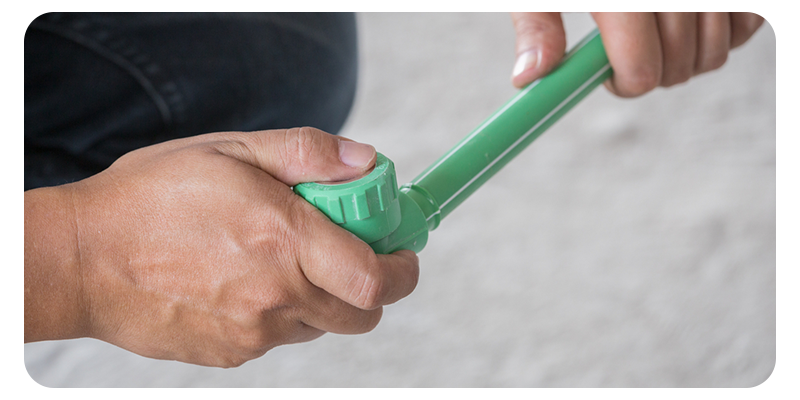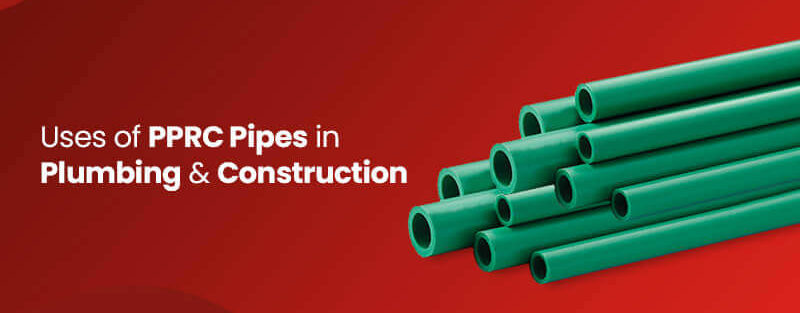Uses of PPRC Pipes in Plumbing and Construction
So, firstly what is the PPRC pipe? PPRC pipe, also called Polypropylene Random Copolymer, is a cylindrical and rigid pipe. Extrusion, a continuous process, is applicable in the creation of this sort of pipes. Typically, these pipes are white or green. The diameter of the most PPRC pipes range from 20mm to 110mm! This implies that PPRC pipes are thicker than PVC counterparts. PPRC pipes also come with a variety of fittings, accessories, and replacement components. Each PPRC pipe diameter has its own set of attachments.
PPRC pipes, like any other pipes, have their own set of characteristics and uses in commercial and industrial sectors. Let’s explore a few of them.
What is PPRC Pipe and How Does it Work?
PPRC – Polypropylene Random Copolymer, it is one of the fundamental plastic pipe products used for hot and cold-water supply system in industrial, residential, and commercial sectors. It is designed in a cylindrical shape form. Hence, it is available in green or white color, with diameter ranges from 20mm to 110mm. The pipe walls are usually thicker as compared to PVC pipes. It is accessible and distinct from other pipes having multiple variations in terms of components, accessories, connections, as well as according to their sizes.
PPRC Pipe and Fittings have a life expectancy of more than 50 years when utilized under correct pressure and temperature conditions.
- It has a 50-year useful life from 20°C to 25°C atmospheric pressures.
- It is applicable at temperatures ranging from -20 °C to +95 °C. (The freezing point of the fluid in the pipe must be able to apply insulation.)
- It is chemically resistant to a considerable degree.
- It is resistant to corrosion. It is also anti-calcification and anti-rusting.
- They do not affect the water’s color, taste, or odor.
- Internal surfaces are smooth and shiny.
- The welding spots have not shrunk in diameter. Has a strong welding capability.
- Assembly time is reduced by 70%, and there are no assembly losses.
- It maintains the heat and sound insulation.
- Exceptionally fire-resistant (Ref: DIN 19560 and DIN 4102)
- Environment-friendly
What are the Most Common Applications for PPRC Pipe Fittings?

PPRC pipes have several advantages in terms of cost, environmental impact, and durability. As a result, these pipes may have various commercial and industrial applications. Continue reading to learn more about the most common applications for PPRC pipe fittings:
In plumbing and building the cold and hot water systems, PPRC pipe fittings are commonly used. PPRC pipes are the first-rate solution for cold and hot water systems because they can resist hot and cold temperatures without breaking or leaking. Furthermore, because of its limited thermal conductivity, the fluids are able to maintain the proper temperature.
PPRC fittings are the preferred method of releasing chemical fluids, such as industrial waste. Due to its capacity to handle potent chemicals and alkaline solutions, PPRC piping is the best pipe fitting for industries.
Purified water supply systems are also made with PPRC pipe fittings. These pipes are long-lasting, with a lifespan of more than 50 years. Furthermore, PPRC pipe fittings stay reliable and never leak or crack even under extreme weather conditions.
The PPRC pipes are ideal to use in the heating system of a building. These pipes can be used in radiant, wall, and floor heating systems. These pipes can endure a variety of surfaces and situations, making them an excellent choice for all of your heating requirements.
What are some Characteristics of PPRC Pipes?
1. Thermal Conductivity is Low
PPRC pipes have low heat conductivity, which is the first thing you should know about them. External temperatures do not expose liquid inside the pipes. Similarly, the temperature of the liquid does not escape the outside world. That is why, during the transport of cold and hot fluids, PPRC pipes reduce heat that is continuously increasing and downgrading.
2. Increased Lifespan
PPRC pipes may last more than 50 years in several environments and with a broad spectrum of fluids. PPRC pipes are also capable of withstanding both cold and hot water systems. PPRC pipes, for example, can withstand the pressure and strain of hot water without breaking.
3. Efficiency in Both the Ecological & Economic Realms
Transporting, cutting, and joining PPRC pipes are simple. These pipes are elementary to operate and do not necessitate additional chemicals or materials.
What are the Distinctions between PPR and PPRC Pipes?

In a nutshell, PPR is a high-tech plastic pipe and it is the critical solution for all hot water systems in modern plumbing. It is also one of the most practical interior materials for the plastic pipe sector similar to PVC pipes. Thanks to its simple installation, sanitary, bright, and smooth inner surface, and lightweight construction, that can be an elementary choice of every expert.
On the other hand, PPRC Pipes are flexible and indestructible because contemporary polymers include in their manufacturing. Constructed from high-grade raw materials, this material is extremely lightweight, making them portable and elementary to use. The most common applications for PPRC pipes are:
- Compressed air systems
- Best water supply systems for drinking water
- Industrial, residential, and commercial piping systems
- Inner & outer structures designed for both hot and cold supplying systems
Is it Possible to Utilize PPR instead of PVC
Most plumbers and civil engineers choose to utilize PPRC for their projects because of its durability. It provides the expected finish for your home or industrial areas. PVC pipes are infamous for fading out quickly and releasing toxins into the water.
Besides this, the cost of PPRC is one of the main reasons due to which most of the business owners dislike it. PPRC is a little more expensive than the regular PVC in Pakistan. However, it appears that this is the situation worldwide. The PPRC is costly, but it is well worth the money.
To Sum Up!
Similar to PVC pipe fittings, PPR pipes have seen a significant expansion in the number and variety of uses in recent years due to their durability, environmental, and economic benefits.Some of the most prevalent applications of PPRC include industrial, residential, and public facilities, all having cold and hot potable water pipelines. Water, aggressive chemicals, hygienic liquids, liquid food items, and compressed air, as well as strongly acidic or alkaline solutions, are all transported through industrial plumbing.



